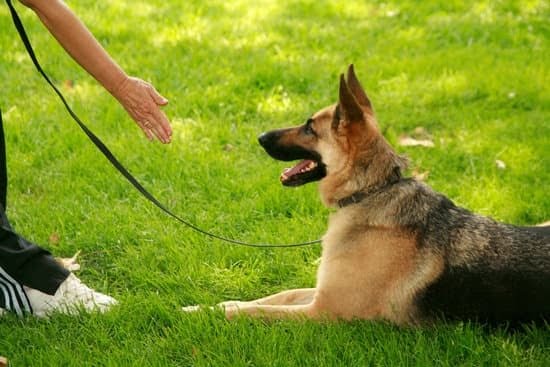Does your furry friend constantly whine, leaving you frustrated and unsure of how to make it stop? In this comprehensive guide on how to train your dog to stop whining, we will delve into the root causes of this behavior and provide effective strategies to address it. Understanding why your dog is whining is crucial in implementing successful training techniques.
Whining in dogs can stem from a variety of reasons, such as seeking attention, expressing anxiety or discomfort, or even signaling physical pain. By pinpointing the underlying cause of your dog’s whining behavior, you can tailor your training approach to effectively address their specific needs. Establishing clear communication with your canine companion is essential in deciphering their whines and responding appropriately.
Positive reinforcement training methods are highly recommended for curbing whining behavior in dogs. By rewarding desirable actions and ignoring or redirecting unwanted behaviors, you can effectively teach your dog to communicate without incessant whining. Consistency is key in implementing these training techniques, reinforcing the desired behavior over time. Stay tuned as we explore practical tips and tricks to help you train your dog to stop whining and foster a harmonious relationship with your loyal companion.
The Negative Effects of Excessive Whining in Dogs
Impact on the Dog
Excessive whining in dogs can have several negative effects on their well-being. This behavior is often a sign of distress, anxiety, or discomfort, and constant whining can lead to increased stress levels for your furry friend. Dogs that whine excessively may also struggle with emotional regulation and may exhibit other unwanted behaviors as a result. It’s important for pet owners to recognize these negative effects and take proactive steps to address the underlying issues causing the whining.
Impact on the Household
Not only does excessive whining have a detrimental impact on the dog itself, but it can also disrupt the harmony within the household. Continuous whining can be disruptive and annoying to family members, neighbors, and even visitors.
In some cases, uncontrolled whining may lead to conflicts or strained relationships among family members who are frustrated by the constant noise. This is why it’s crucial to address this behavior early on and work towards reducing or eliminating it through proper training techniques.
Health Consequences
In addition to emotional and behavioral repercussions, excessive whining in dogs can also have health consequences. The stress caused by chronic whining can weaken your dog’s immune system, making them more susceptible to illnesses and diseases.
Moreover, continuous whining can lead to physical issues such as vocal cord strain or injuries if the dog is exerting too much effort in producing loud vocalizations. By understanding the negative effects of excessive whining, pet owners can take steps to help their furry companions overcome this behavior through effective training methods and support.
Establishing Clear Communication With Your Dog
One of the key steps in training your dog to stop whining is to establish clear communication with them. Dogs often whine as a way of expressing their needs or emotions, so it’s important for you to understand what they are trying to communicate.
Pay attention to the context in which your dog whines – are they seeking attention, feeling anxious, or in need of something like food or water? By identifying the root cause of their whining behavior, you can address it effectively and prevent it from becoming a persistent issue.
Be patient and consistent in reinforcing these commands so that your dog learns what is expected of them. Remember that dogs respond well to positive reinforcement, so be sure to reward them when they follow your instructions and stop whining.
In addition to verbal cues and rewards, you can also use body language and gestures to communicate with your dog effectively. Dogs are highly attuned to human body language and facial expressions, so use these cues to signal your approval or disapproval of their behavior.
Maintain eye contact with your dog when giving commands and use hand signals along with verbal cues for better clarity. By establishing clear communication through a combination of verbal commands, body language, and positive reinforcement, you can train your dog to stop whining effectively while strengthening the bond between you and your furry companion.
| Key Points | Details |
|---|---|
| Understanding Whining Behavior | Identify the root cause of your dog’s whining to address it effectively. |
| Consistency in Communication | Use clear verbal cues, body language, and gestures consistently for effective training. |
| Positive Reinforcement | Reward your dog for following instructions and stopping whining behavior. |
Positive Reinforcement Training Methods for Whining Behavior
When dealing with a dog that constantly whines, it is essential to implement positive reinforcement training methods to address this behavior effectively. Positive reinforcement involves rewarding your dog for exhibiting the desired behavior, in this case, not whining. This method focuses on praising and offering treats or toys when your dog remains quiet and calm, thereby reinforcing the idea that being quiet leads to positive outcomes.
One effective way to use positive reinforcement to train your dog to stop whining is by ignoring the behavior when it occurs. Dogs often whine to get attention or something they want, so reacting to their whining by giving in to their demands only reinforces this behavior. Instead, wait for a moment of silence or when they stop whining before offering praise and treats. This approach teaches them that staying quiet leads to rewards and attention.
Another positive reinforcement training method for addressing whining behavior is teaching an alternative behavior such as “quiet” or “settle.” When your dog begins to whine, prompt them with a command like “quiet” and reward them when they stop vocalizing. Consistency is crucial in this training technique – reinforce the desired behavior every time they respond correctly. Over time, your dog will learn that following the command results in positive reinforcement, leading to a decrease in whining overall.
| Positive Reinforcement Training Methods | Effectiveness |
|---|---|
| Ignoring Whining Behavior | Effective in discouraging attention-seeking whining |
| Teaching Alternative Behaviors | Helpful in providing dogs with an alternative action instead of whining |
Providing Mental and Physical Stimulation to Prevent Whining
Dogs, like humans, need mental and physical stimulation to keep them happy and healthy. Oftentimes, excessive whining in dogs can be a result of boredom or lack of exercise. By providing your furry friend with the right amount of mental and physical stimulation, you can prevent whining behaviors before they even start. Here are some ways on how to train your dog to stop whining through stimulation:
- Interactive Toys: Invest in puzzle toys or treat-dispensing toys that will challenge your dog mentally and keep them entertained for hours. This will not only prevent boredom but also redirect their focus from whining.
- Daily Exercise: Make sure your dog gets enough physical exercise every day to burn off excess energy. Whether it’s a long walk, a play session at the park, or even obedience training, keeping your dog active will help reduce whining due to pent-up energy.
- Training Games: Incorporate training games into your routine to engage your dog’s brain and reinforce positive behaviors. Simple commands like sit, stay, or fetch can provide mental stimulation while reinforcing good manners.
In addition to mental and physical stimulation activities, it’s important to also ensure that your dog is getting enough rest and relaxation. Just like humans, dogs need downtime to recharge and unwind. By finding the right balance between playtime and rest time, you can help prevent whining due to overstimulation or exhaustion.
Remember that every dog is unique, so it may take some trial and error to find the right combination of activities that work best for your furry companion. By prioritizing mental and physical stimulation in your dog’s daily routine, you’ll not only keep them happy and engaged but also effectively address any whining behavior before it becomes a persistent issue.
Consistency Is Key
Training your dog to stop whining requires a consistent and structured approach. By establishing a clear training plan, you can effectively address this behavior and help your furry companion become more calm and content. Here are some steps to create a whining behavior training plan for your dog:
- Identify Triggers: Start by identifying what triggers your dog’s whining behavior. Is it when they are hungry, bored, anxious, or seeking attention? Understanding the root cause will help you address the issue more effectively.
- Set Clear Rules: Establish clear rules and boundaries for your dog when it comes to whining. Let them know that excessive whining is not acceptable behavior. Consistency in enforcing these rules is crucial for the training process.
- Implement Positive Reinforcement: Use positive reinforcement techniques such as treats, praise, or toys to reward your dog when they exhibit calm and quiet behavior. This will help reinforce the desired behavior and encourage them to stop whining.
Creating a daily routine that includes mental and physical stimulation can also help prevent excessive whining in dogs. Providing enough exercise, playtime, and interactive toys can keep your dog engaged and fulfilled, reducing their need to whine for attention or boredom. Remember, a tired and stimulated dog is less likely to engage in unwanted behaviors like whining.
By following a consistent training plan and providing the right stimulation for your dog, you can effectively teach them how to control their urge to whine. With patience, dedication, and positive reinforcement, you can help your canine companion develop healthier coping mechanisms and behaviors. Remember that every dog is different, so be sure to tailor your training plan to suit your pet’s unique needs and personality traits.
Addressing Separation Anxiety and Whining in Dogs
Separation anxiety is a common issue among dogs and can manifest in various behaviors, including excessive whining. Dogs are social animals and may become distressed when left alone for extended periods. Understanding the root cause of your dog’s separation anxiety is crucial in addressing their whining behavior.
Recognizing Symptoms of Separation Anxiety
Signs of separation anxiety in dogs can range from whining, destructive chewing, pacing, and even attempts to escape. It’s essential to differentiate between normal behavioral responses to being left alone and true separation anxiety. If your dog exhibits distressing behaviors consistently when you leave, it may be due to separation anxiety rather than simple boredom or lack of training.
Implementing Training Techniques for Separation Anxiety
Training your dog to cope with being alone can help reduce their whining due to separation anxiety. Gradual desensitization by leaving your dog alone for short periods and gradually increasing the time spent away can help them adjust. Providing comfort items like their favorite toys, blankets, or shirts with your scent can also help ease their anxiety when you’re not around. It’s crucial to make departures and arrivals calm and uneventful to avoid worsening their anxiety.
Seeking Professional Assistance
If your dog’s whining due to separation anxiety persists despite your efforts, seeking professional help from a certified dog trainer or a veterinary behaviorist may be necessary. They can assess your dog’s specific needs and create a tailored training plan to address their separation anxiety effectively.
Medication may also be prescribed in severe cases to alleviate your dog’s distress and facilitate training progress. Remember that patience, consistency, and positive reinforcement are key elements in helping your furry companion overcome separation anxiety-induced whining behavior.
Seeking Professional Help for Persistent Whining Issues
Addressing persistent whining issues in dogs can be challenging, especially if the root cause of the behavior is complex or deeply ingrained. If you have tried various training methods and strategies to no avail, seeking professional help may be the best course of action. A certified dog trainer or animal behaviorist can provide valuable insights and expertise in addressing your dog’s whining behavior effectively.
Professional help can involve a thorough assessment of your dog’s behavior and environment to pinpoint the underlying cause of the whining. The trainer or behaviorist may also observe interactions between you and your dog to identify any unintentional reinforcement of the whining behavior. With their experience and knowledge, they can tailor a training plan specifically designed to address your dog’s unique needs and challenges.
In addition to personalized training plans, professional help can also offer support and guidance for you as a pet owner. They can teach you effective techniques on how to communicate with your dog, set boundaries, and reinforce desired behaviors. By working closely with a professional, you can gain confidence in handling your dog’s whining behavior effectively and setting them up for long-term success in overcoming this issue.
Celebrating Progress
In conclusion, training your dog to stop whining requires patience, consistency, and understanding of your furry friend’s behavior. By first identifying the root cause of the whining, whether it be boredom, anxiety, or seeking attention, you can address the issue effectively. Negative effects of excessive whining in dogs can lead to stress for both you and your pet, making it crucial to establish clear communication and boundaries.
Positive reinforcement training methods are highly effective in teaching your dog to stop whining. By rewarding good behavior and ignoring whining, you can communicate to your dog what is acceptable and what is not. Providing mental and physical stimulation through exercise and interactive toys can also help prevent whining by keeping your dog stimulated and engaged.
Consistency is key when creating a training plan for whining behavior. Set clear expectations for your dog and remain firm in enforcing these rules. Remember that addressing separation anxiety may also play a role in your dog’s whining behavior, so be patient and understanding as you work through these challenges.
And don’t hesitate to seek professional help if persistent issues arise. Celebrate every small progress made by rewarding your dog’s improved behavior, reinforcing the positive changes you have successfully implemented through training on how to train your dog to stop whining. Your efforts will ultimately result in a happier and more well-behaved companion for life.
Frequently Asked Questions
How Do I Get My Dog to Stop Whining at Everything?
To get your dog to stop whining at everything, it is important to first identify the root cause of the behavior. It could be due to boredom, anxiety, discomfort, or seeking attention. Addressing the underlying issue through proper exercise, mental stimulation, comfort, or attention can help reduce the whining.
Why Does My Dog Constantly Whine for Attention?
Dogs may constantly whine for attention due to various reasons such as feeling lonely, seeking companionship, or simply wanting interaction with their owners. It is essential to provide enough mental and physical stimulation for your dog to prevent excessive whining as a way to seek attention.
Should You Ignore a Whining Dog?
Ignoring a whining dog can be a helpful approach in some situations where the whining is due to attention-seeking behavior. If you give in to your dog’s whining by providing attention or treats, it reinforces this behavior.
However, ignoring should not be done when the dog is signaling distress or discomfort that needs immediate addressing. In such cases, it’s essential to identify the cause of the whining and address it accordingly.

Welcome to the blog! I am a professional dog trainer and have been working with dogs for many years. In this blog, I will be discussing various topics related to dog training, including tips, tricks, and advice. I hope you find this information helpful and informative. Thanks for reading!





